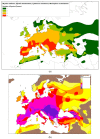Bats and Viruses: Emergence of Novel Lyssaviruses and Association of Bats with Viral Zoonoses in the EU
- PMID: 30736432
- PMCID: PMC6473451
- DOI: 10.3390/tropicalmed4010031
Bats and Viruses: Emergence of Novel Lyssaviruses and Association of Bats with Viral Zoonoses in the EU
Abstract
: Bats in the EU have been associated with several zoonotic viral pathogens of significance to both human and animal health. Virus discovery continues to expand the existing understating of virus classification, and the increased interest in bats globally as reservoirs or carriers of zoonotic agents has fuelled the continued detection and characterisation of new lyssaviruses and other viral zoonoses. Although the transmission of lyssaviruses from bat species to humans or terrestrial species appears rare, interest in these viruses remains, through their ability to cause the invariably fatal encephalitis-rabies. The association of bats with other viral zoonoses is also of great interest. Much of the EU is free of terrestrial rabies, but several bat species harbor lyssaviruses that remain a risk to human and animal health. Whilst the rabies virus is the main cause of rabies globally, novel related viruses continue to be discovered, predominantly in bat populations, that are of interest purely through their classification within the lyssavirus genus alongside the rabies virus. Although the rabies virus is principally transmitted from the bite of infected dogs, these related lyssaviruses are primarily transmitted to humans and terrestrial carnivores by bats. Even though reports of zoonotic viruses from bats within the EU are rare, to protect human and animal health, it is important characterise novel bat viruses for several reasons, namely: (i) to investigate the mechanisms for the maintenance, potential routes of transmission, and resulting clinical signs, if any, in their natural hosts; (ii) to investigate the ability of existing vaccines, where available, to protect against these viruses; (iii) to evaluate the potential for spill over and onward transmission of viral pathogens in novel terrestrial hosts. This review is an update on the current situation regarding zoonotic virus discovery within bats in the EU, and provides details of potential future mechanisms to control the threat from these deadly pathogens.
Keywords: bats; emerging; lyssavirus; novel; rabies; zoonoses.
Conflict of interest statement
The authors declare no conflict of interest.
Figures


Similar articles
-
Renewed Public Health Threat from Emerging Lyssaviruses.Viruses. 2021 Sep 4;13(9):1769. doi: 10.3390/v13091769. Viruses. 2021. PMID: 34578350 Free PMC article.
-
Bats and lyssaviruses.Adv Virus Res. 2011;79:239-89. doi: 10.1016/B978-0-12-387040-7.00012-3. Adv Virus Res. 2011. PMID: 21601050 Review.
-
[Rabies in bats].Klin Mikrobiol Infekc Lek. 2016 Jun;22(2):68-74. Klin Mikrobiol Infekc Lek. 2016. PMID: 27450525 Czech.
-
Lyssaviruses and bats: emergence and zoonotic threat.Viruses. 2014 Aug 4;6(8):2974-90. doi: 10.3390/v6082974. Viruses. 2014. PMID: 25093425 Free PMC article. Review.
-
Bat lyssavirus infections.Rev Sci Tech. 2000 Apr;19(1):177-96. doi: 10.20506/rst.19.1.1221. Rev Sci Tech. 2000. PMID: 11189715 Review.
Cited by
-
Metagenomic analysis reveals presence of different animal viruses in commercial fetal bovine serum and trypsin.Zool Res. 2022 Sep 18;43(5):756-766. doi: 10.24272/j.issn.2095-8137.2022.093. Zool Res. 2022. PMID: 35975611 Free PMC article.
-
Comparison of Pan-Lyssavirus RT-PCRs and Development of an Improved Protocol for Surveillance of Non-RABV Lyssaviruses.Viruses. 2023 Mar 4;15(3):680. doi: 10.3390/v15030680. Viruses. 2023. PMID: 36992389 Free PMC article.
-
Conference Report: LPMHealthcare Emerging Viruses 2023 (EVOX23): Pandemics-Learning from the Past and Present to Prepare for the Future.Pathogens. 2024 Aug 10;13(8):679. doi: 10.3390/pathogens13080679. Pathogens. 2024. PMID: 39204279 Free PMC article.
-
A Review of Mammarenaviruses and Rodent Reservoirs in the Americas.Ecohealth. 2022 Mar;19(1):22-39. doi: 10.1007/s10393-022-01580-0. Epub 2022 Mar 5. Ecohealth. 2022. PMID: 35247117 Free PMC article. Review.
-
Novel Bat Lyssaviruses Identified by Nationwide Passive Surveillance in Taiwan, 2018-2021.Viruses. 2022 Jul 18;14(7):1562. doi: 10.3390/v14071562. Viruses. 2022. PMID: 35891542 Free PMC article.
References
-
- Banyard A.C., Fooks A.R. The impact of novel lyssavirus discovery. Microbiol. Aust. 2017;38:18–21. doi: 10.1071/MA17006. - DOI
-
- Marston D.A., Horton D.L., Nunez J., Ellis R.J., Orton R.J., Johnson N., Banyard A.C., McElhinney L.M., Freuling C.M., Firat M., et al. Genetic analysis of a rabies virus host shift event reveals within-host viral dynamics in a new host. Virus Evol. 2017;3:vex038. doi: 10.1093/ve/vex038. - DOI - PMC - PubMed
Publication types
Grants and funding
LinkOut - more resources
Full Text Sources

